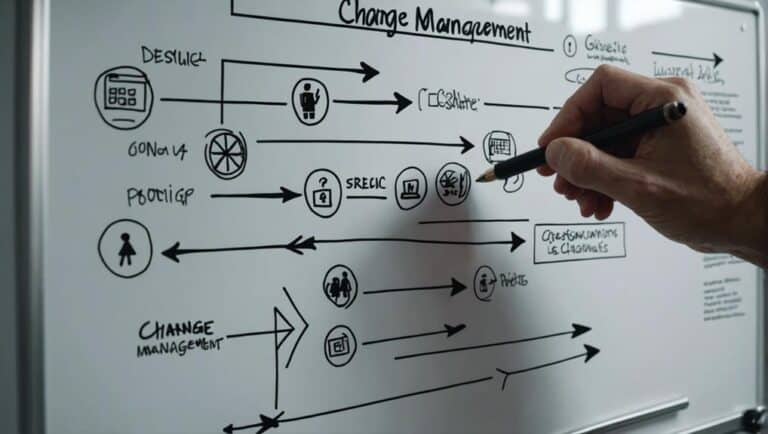Being in change management can be exciting and fulfilling, but on the other hand, some challenges can make the change difficult. Changing and transforming companies is quite a difficult enough task and this process is sometimes met with resistance and suspicion, further complicating the situation.
Change management is hard because of factors that include: fear of change, company culture problems, and lack of training. Executives, in particular, can be slow to support or quick to react emotionally. Additionally, you might find that time and cost issues and new technologies can pose challenges.
If you want to know more, I will expand on all the above reasons and explain a few others. Understanding all the different challenges in change management can help you avoid them in the future.
1. Fear of Change Can Hinder Change Management Efficiency
It is human nature to fear and resist anything that might change our life as we know it. Managers and employees might agree in principle that they need to make changes—but when it comes to implementation, they might not be as open or cooperative as you may have hoped. It’s only natural that they fear losing their usual way of operating, especially if there’s a history of failed attempts at implementing real change.
An even bigger problem occurs when there’s resistance in the later stages, as employees start to deal with more significant challenges. Issues that may have seemed insignificant at first become bigger and bigger, discouraging employees further and stifling any chance of meaningful change.
Knowing that resistance is natural and inevitable can help change management teams’ plans and create good practices to deal with this problem. Getting past resistance and doubt among employees is not easy, but it paves the way for a smooth transition.
2. Company Culture May Make Company Change Difficult
Change management becomes problematic when the company culture discourages change and improvement. The company culture is influential; it affects all employees’ performance, engagement, and attitude, whether they realize it or not. A healthy organizational culture can be instrumental in changing management. Unfortunately, the opposite is just as influential.
Problematic company culture makes it much harder for change management teams to help a company achieve much-needed improvements. Often companies foster an internal environment that encourages distrust towards new ways of thinking and working. These cultural issues cause employees to focus on individual rather than common priorities and resist any attempt to challenge the status quo.
Change management teams must consider company culture at every step of the process. They should identify the particular problems that might be causing resistance and figure out ways to deal with them as soon as possible to avoid more significant issues later on.
3. Miscommunication between Management and Staff
Communication is essential for change management in every step of the process. Understandably, any significant change or improvement in a company can confuse all levels of employees. Everyone needs to know precisely which roles, tasks, and goals are changing to understand what management expects from their employees.
Ineffective communication can make it much harder for change management teams to achieve their desired results. Sometimes the information is insufficient, causing some employees to be confused, or worse, fill in the gaps by themselves and misunderstand the purpose of the whole process.

Other times companies don’t involve all the stakeholders in the communication process, making it even more difficult and time-consuming to implement actual change.
Miscommunication can cost change management time and money, so they need to make sure that every bit of information goes to everyone involved. A good start would be ensuring every stakeholder is informed about the details of the change process.
Additionally, companies should be careful to choose the right message and messenger for different levels of employees. For significant changes, a simple company-wide memo is not enough.
4. Adapting to New Technologies May Be Challenging
Change management teams often deal with introducing new technologies to a business as part of the change process. As fast as technology moves nowadays, companies need to update their technologies to keep up constantly. Change management can help make these transitions smooth.
However, some new technologies can fundamentally change how a part of the company operates, leading to employees having significant difficulties adapting. It’s only natural, given some employees’ limited training and skills and the rapid pace of technological developments. However, it’s also a problem that can make it difficult for change management teams to go to the next stage of their process.
Problems with new technologies are another difficulty that people working in change management should consider and find ways to solve. One possible solution is introducing new technologies in phases, first to the more tech-savvy employees and then to others, giving those who are hesitant enough time to adapt.
5. Managing Different Player Expectations Is Complex
In many ways, a company works like a living organism, a complex collection of smaller units with their functions and needs. It can be challenging for a change management team to effectively deal with and communicate with many groups with varying roles and goals within a single company.
Change management must deal with all the different stakeholders in a business, and every one of them might need a different approach and training. The team should be able to find the right way to manage multiple priorities at the same time.
For instance, if a change management team is helping a company introduce and embrace new manufacturing technologies, they will need different approaches. Executives probably will need to know how the technology will affect them in the long run, while floor employees will be more concerned with how the new technology will affect their everyday tasks.
6. Emotions Come Into Play in Change Management
It’s essential to remember the human factor: you’re dealing with human beings that have their perceptions and ideas. They may not understand your point of view and may be unable to apply cold logic to the situation, mainly when it affects them so much. You may face resistance and adverse reactions throughout your change management project, making your job more challenging.

What makes the change management process even harder is that many people don’t realize their emotional response, refusing to accept that they might be contributing to additional, possibly costly issues. Therefore, they create other difficulties in an already challenging process.
7. Lack of Training May Affect Change Management Success
Some companies may pose unique challenges that may put change management teams in a difficult position. No matter how experienced and knowledgeable you may be about change management, new problems and players can continuously operate in ways you couldn’t foresee. Consequently, your team may not be able to achieve the results they were aiming to achieve.
It could be helpful to train for unforeseen circumstances and learn as much as possible about ways of dealing with unknown problems. More importantly, change management teams should try to instil a particular mindset of persisting and adapting to unforeseen changes in the process.
8. Time and Pace Issues in Change Management
Timing is a significant aspect that can make or break a change management project. There’s no manual for deciding how long a particular task is supposed to take and where you should place the milestones along the way. Choosing the time and pace of a change management project can be very difficult.
Some cases might require fast and decisive action over a short period, and others might require a long-term program with gradual changes. Deciding on the time and pace needed for a change management project is crucial to the whole project and its success, which is why teams need to be very thorough when examining all the possible options.
Often change is implemented too slowly to have any value by the end of the process. Because of the many challenges surrounding it, the process can experience manymore delays than anticipated.
As a result, there will inevitably be funding issues, which can only delay the process more. Sometimes teams need to emphasize the urgency of the situation to make sure that significant change will happen as soon as possible.
9. Cost Issues When Managing Company Changes
Cost issues are probably some of the most widespread daily challenges that change management teams face. There’snot enough information about change management and what it is supposed to achieve, so companies sometimes don’t know how much time and resources it requires.
It’s sad but often true, many companies don’t clearly understand what change management teams are supposed to do and don’t value their importance. As a result, they allocate minimum resources to what is supposed to be a major change management project with significant implications.
Change management requires time, effort, and resources to succeed. It’s not something anyone can do, and it’s not optional regarding change within a company. Having limited resources makes change management much harder and will inevitably cost a company much more in the long run.
10. Lack of Support From Company Leadership
To implement change well and fast, change management teams should have company leaders on their side. Leaders can set the tone and communicate effectively to convince and support the rest of the company. However, this isn’t always the case.
Some company executives don’t understand what change management is trying to achieve and what they need to do as part of the change process.
Because their understanding of the purpose and process of change is poor, their decisions and actions fail to take change into account properly. For instance, they can refuse to engage frequently with the change management teams or to communicate the goals to the rest of their teams.
Change management teams should try to communicate consistently with the leadership and be open to any questions they pose. It’s important to reassure them and clarify the goals and purposes. This way, they understand what change management is, what it’s trying to achieve with their company, and what they need to succeed.
11. Difficulties in Managing All the Company Assets
Change management involves all the different assets and resources of a company, which can be a lot to handle, even for a highly skilled team. The job becomes even harder when you consider that you’ll have to deal with all of these aspects while trying to implement crucial changes in a company.
Dealing with the human aspect alone poses its challenge, as I mentioned above, but this is only a part of the puzzle you and your team need to solve. You should consider every other aspect and how it factors into the change you’re trying to implement. These aspects include physical and financial assets, information, and human resources.
12. No Indicators To Measure Successful Company Change
There’s no way of knowing how far you’ve progressed regarding the change process unless you find a way to measure change. Often, change management fails to determine factors that will serve as indicators of success. As a result, there is confusion about the level of progress and the success of achievements over time.
Change management teams should be careful to define indicators of progress and success before starting the process. By having metrics in place, they can see the results of their work and communicate them to the people affected. However, there’s no reason to go the other direction and introduce an overwhelming number of metrics to consider.

13. Not Everyone Realizes the Need for Change
As we have extensively covered so far, the change process can be difficult even to grasp, let alone implement. Because it’s such an important but difficult challenge, everyone affected by it should realize why the company needs to change in the first place.
By making everyone understand why change is happening, your team will have an easier time implementing it because there will be less resistance or emotional reactions.
Understanding and believing in the need for transformation will prepare employees for future challenges and the work needed to confront them. Every level of employees needs to be aware of the need for change and to believe in the ability of the leadership, the management team, and themselves to implement real and significant change.
Sources
- Harvard Business Review: The Hard Side of Change Management
- CIO: 10 hard truths of change management
- Change Strategists: What Is Change Management? – A Beginners Guide
- Change Strategists: Why Do Managers Resist Change? 5 Key Reasons + How to Overcome Them
- Change Strategists: Why Is Internal Business Environment Important?
- Nibusinessinfo.co.uk: Cost of change management
- Prosci.com: Metrics for Measuring Change Management
- Change Strategists: The Key Internal and External Barrier to Change in Business
- Change Strategists: How to train your employees for change





